In India’s Chennai, River Restoration Lands Hardest on the Poor
In a resettlement colony on the outskirts of Chennai, a sprawling industrial city on India’s Bay of Bengal, rows of beige tenements rise out of marshland in clusters, blocking out the sky in a uniform grid. Construction materials line the first floor of buildings, and bulldozers roll through the wide and dusty streets. Vijay Vasanth says he arrived here in early January on government provided transport. His family and their belongings were left on the sidewalk in the middle of the settlement, named Perumbakkam. “When we came here, we had to be homeless.” Vasanth said, “They just lifted us and dropped us here, now we have to stay.”
Vasanth says he grew up in the heart of Chennai, the capital of the state of Tamil Nadu, in a neighborhood alongside the Cooum River called Sathyavani Muthu Nagar. But in late 2019, officials evicted 500 families living there, Vasanth included, without initially informing residents why they were evicted or where they were going. They were the first batch of 2,092 families set to be evicted. “They started marking our houses by writing letters and numbers on the door,” said Vasanth. He asked why and was told it was because his house was along the river. The markings on the door were to tell the families their house was set for demolition.
The families — like tens of thousands of families before them — were moved to settlement colonies like this one, miles from the city center and far from the sources of work and income that they once knew. When they arrived, the apartments they finally moved into did not have running water or electricity. “There was only one light, an emergency light on the veranda,” said Vasanth, who has struggled to find work. It is too expensive to travel to central Chennai, where he sold electronics, nearly 19 miles away. “For three months we struggled hard. We were stir crazy,” he said.
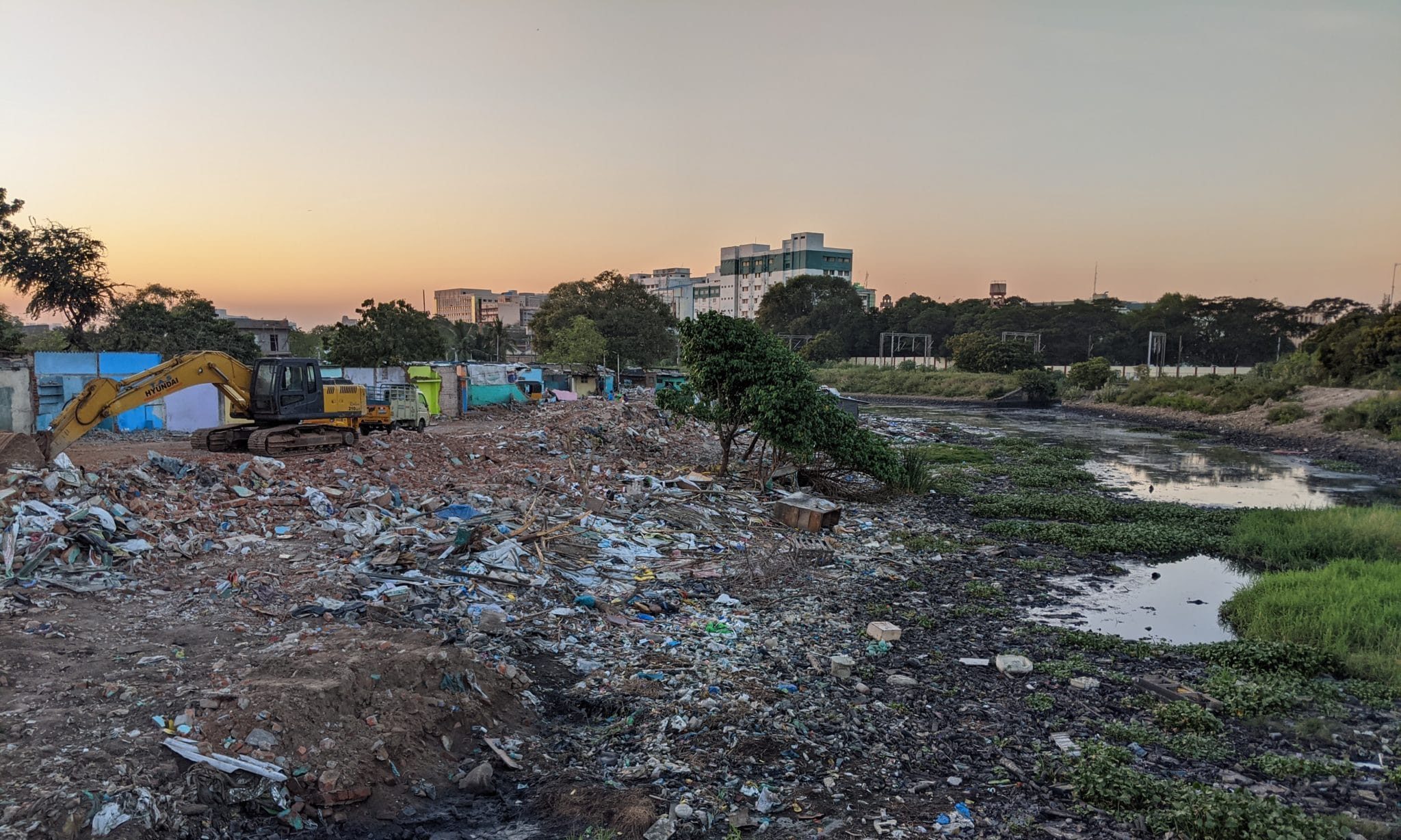
It’s a familiar sentiment. Sathyavani Muthu Nagar is one of hundreds of informal settlements in the process of being demolished by Chennai officials — part of a vast effort, they say, to restore the city’s heavily polluted and constricted waterways. The government’s first step, according to project documents, is what is officially called “slum clearance” or the removal of “encroachments.”
Supporters of these restoration initiatives say they are sorely needed. Chennai’s rivers are plagued by rampant pollution and overdevelopment, leaving them uniquely vulnerable. Science suggests that both problems are only amplified by climate change and will continue to be so in coming years. The long-term goal, officials say, is the restoration of crucial riverbank wetlands that can act as a buffer against both flood and drought.
The neighborhood clearance projects are carried out in coordination with various municipal organizations, including the Chennai Rivers Restoration Trust (CRRT), the state Public Works Department (PWD), and the Tamil Nadu Slum Clearance Board (TNSCB). The problem, critics say, is that the implementation of these otherwise well-intentioned programs weighs heavily on — and has little regard for — the thousands of low-income inhabitants eking out already difficult lives in dozens of informal communities along Chennai’s rivers.
Indeed, under the new eco-restoration initiatives, it is not just the 2,092 families in Sathyavani Muthu Nagar — including Vasanth’s — whose lives will be impacted. Nearly 60,000 families, or roughly 200,000 people, are currently marked for eviction from the banks of Chennai’s rivers, according to the TNSCB, which handles the relocation of residents. The families are considered to be living in “objectionable locations,” which means in low-lying, flood-prone areas. Many have already been relocated.
But experts worry that at best, these environmental initiatives — while ostensibly for the common good — will continue to result in severe consequences for the city’s poor. At worst, they say, climate change and ecological restoration are being used as pretenses for evacuating the city’s slums so that new and equally imprudent infrastructure can be built. “Even without climate change, we are a city that has been built to drown itself,” said writer Nityanand Jayaraman, who works on environmental justice campaigns in Chennai. “We don’t need extreme weather events. Regular weather events are enough to finish us off.”
Either way, what is officially referred to in project documents as “resettlement and rehabilitation” of families invariably results in them being sent, often against their will, to distant settlements referred to by housing advocates as ghettos, or satellite slums. “Is this restoration?” asked Vanessa Peter, a researcher at the Information and Resource Center for the Deprived Urban Communities (IRCDUC), a Chennai-based information clearinghouse for the city’s poor. “Or is this just another way of convincing everybody that we should get rid of our slums?”
In a video posted to YouTube in 2015, a crowd can be seen standing on a concrete bridge spanning the Cooum River — one of three major rivers coursing through the city — watching the swollen water rush underneath. It laps against the bridge, threatening to rise up and over the wall onto the road. On either side of the waterway, rooftops are visible above the turbid, olive-green water. The structures are almost completely underwater. Another video, taken from a bridge near the neighborhood of Koyambedu, shows a similarly bleak reality: the Cooum flowing over more rooftops, some houses completely washed away. Seen from overhead, the vulnerability of the city is staggering. Few areas lie above sea level; the rest is swallowed by water.
In 2015, this particular flood, deemed a once-in-a-hundred-year event, damaged or destroyed nearly 500,000 houses, killed at least 470 people, and caused $3 billion in economic losses, according to official estimates. The flooding disproportionately impacted the city’s poor, who mostly lived in low-lying settlements along the river.
Following this historic rainfall, a series of abnormally weak monsoons and a subsequent heatwave resulted in a severe drought that peaked in 2019 with the city’s main reservoirs running dry.
Of course, cycles of flood and drought have been a feature of life on the Bay of Bengal for millennia. But with climate change pushing the Bay of Bengal ever further inland, studies suggest that water-proximate, pollution-clogged neighborhoods like Sathyavani Muthu Nagar are facing a future of continued inundation. On top of a swelling sea, the city faces an increase of extreme weather events as the northeast monsoon gets stronger.
But Chennai’s problems, critics say, are as much structural as meteorological. “People have the tendency to hide behind climate change,” said S. Janakarajan, president of the South Asia Consortium for Interdisciplinary Water Resources Studies and an expert on water management. Drought and flood, he said, are as much a result of Chennai’s rapid development as they are of extreme weather.
Ecologically vital wetlands, estuaries, and rivers fell victim to decades of negligent land-use policy and an insatiable urban sprawl. Over the past 40 years, paved surfaces have expanded 10 times over, according to a report by Care Earth, a nonprofit that does extensive restoration work throughout the city. Jayshree Vencatesan, a managing trustee of biodiversity and conservation with the organization, noted that in order to build the industrial center and house an expanding population, developers of flashy IT campuses and looming apartment buildings deliberately cut off rivers, lakes, and wetlands. “Once that is done, the land becomes dry and very easy to convert,” said Vencatesan. “These landscapes were usurped by the big players.”
These wetlands and waterways serve as systems for recharging the city’s aquifers, absorbing heavy rain and providing drinking water for the city, and climate change is likely to challenge the wisdom of this development. According to a report published in the aftermath of the 2015 flood by the Citizen Consumer and Civic Action Group, a local consumer and environmental advocacy group, the increased frequency of climate change-amplified events threatens to exacerbate already pressing environmental problems. The report called for extensive mapping of the storage and carrying capacities of local waterbodies, which had degraded due to “incessant construction on the waterbodies, dumping of debris, and encroachments.”
And yet, when it comes to addressing issues like these, Jayaraman said blame too often falls on informal settlements like Sathyavani Muthu Nagar, and the primary focus of the post-2015 restoration push remains the elimination of Chennai’s riverside communities. That’s because these informal settlements are often built directly into the riverbank and are perceived by many officials — as well as Chennai’s middle-and upper-class residents — as making the flooding worse, mainly by blocking the drainage area. And so ecological restoration of the Cooum focuses on “slum eviction as an achievable first step,” noted a 2010 analysis written by Karen Coelho, a scholar of urban ecology and associate professor at the Madras Institute of Development Studies, and urban planner and community advocate Nithya Raman.
“This shortcut approach is openly announced,” the paper continued, “confidently addressing a growing urban middle-class constituency who hold slum-dwellers responsible for the state of the rivers, and regard their summary removal as the crux of eco-restoration.”
As climate change increasingly lays bare the city’s complex ecological crisis, nearly all interventions seem to begin with this familiar logic. “For some strange reason,” said Jayaraman, “they believe that the only encroachers in the city that are problematic are the poor.”
Such thinking leaves some of the more complicated realities of city-wide ecological restoration unaddressed, Jayaraman and other say. These include deeper, more harmful ecological disruptions, like the decimation of vital wetlands outside the city, or mega-projects like the port expansion being pursued by multinational company Adani, which will affect nearly 3,000 acres of critical tidal wetlands north of the city, threatening local fishing towns.
The eviction drive stems from a post-flood call from the chief minister of Tamil Nadu for massive investment in housing for those most affected. Despite a 2016 high court order that directed the government to examine resettling riverside residents “near the area where they were originally relocated,” CRRT-driven evictions have increasingly sent these families to hastily-built colonies on the periphery of the city. In a resettlement action plan prepared by the Tamil Nadu Housing and Habitat Development Project, with funding from the World Bank, the authors acknowledge the need for new housing, not just because of a housing shortage, but as a clear climate issue, citing CRRT’s work as expected to “contribute positively” in “managing climate-induced extreme events.”
But CRRT, a wholly owned division of the Tamil Nadu government, has long been criticized for using ecological restoration as a mere pretext for allowing new development projects. In their 2010 article, Coelho and Raman described CRRT’s first project along the Adyar River, which evicted hundreds of huts and threatened thousands more with demolition. The aim was to create an eco-park and restore local flora, fauna, and the ecological function of the river. But the Tamil Nadu government had already permitted new office buildings, multi-storied luxury residential complexes, and five-star hotels on what was left of the estuary at the mouth of the river, irreversibly damaging the fragile ecology of the creek. “These efforts to restore the creek were already moot,” Coelho and Raman wrote.
Further complicating matters, the relocation settlements are often built on wetlands themselves, like the colony Kannagi Nagar, which filled in part of the essential Pallikaranai wetland to avoid flooding, and in the process blocked drainage of the Okkiyam Maduvu channel, an estuary so ecologically critical it has been dubbed the “aorta” of the marsh.
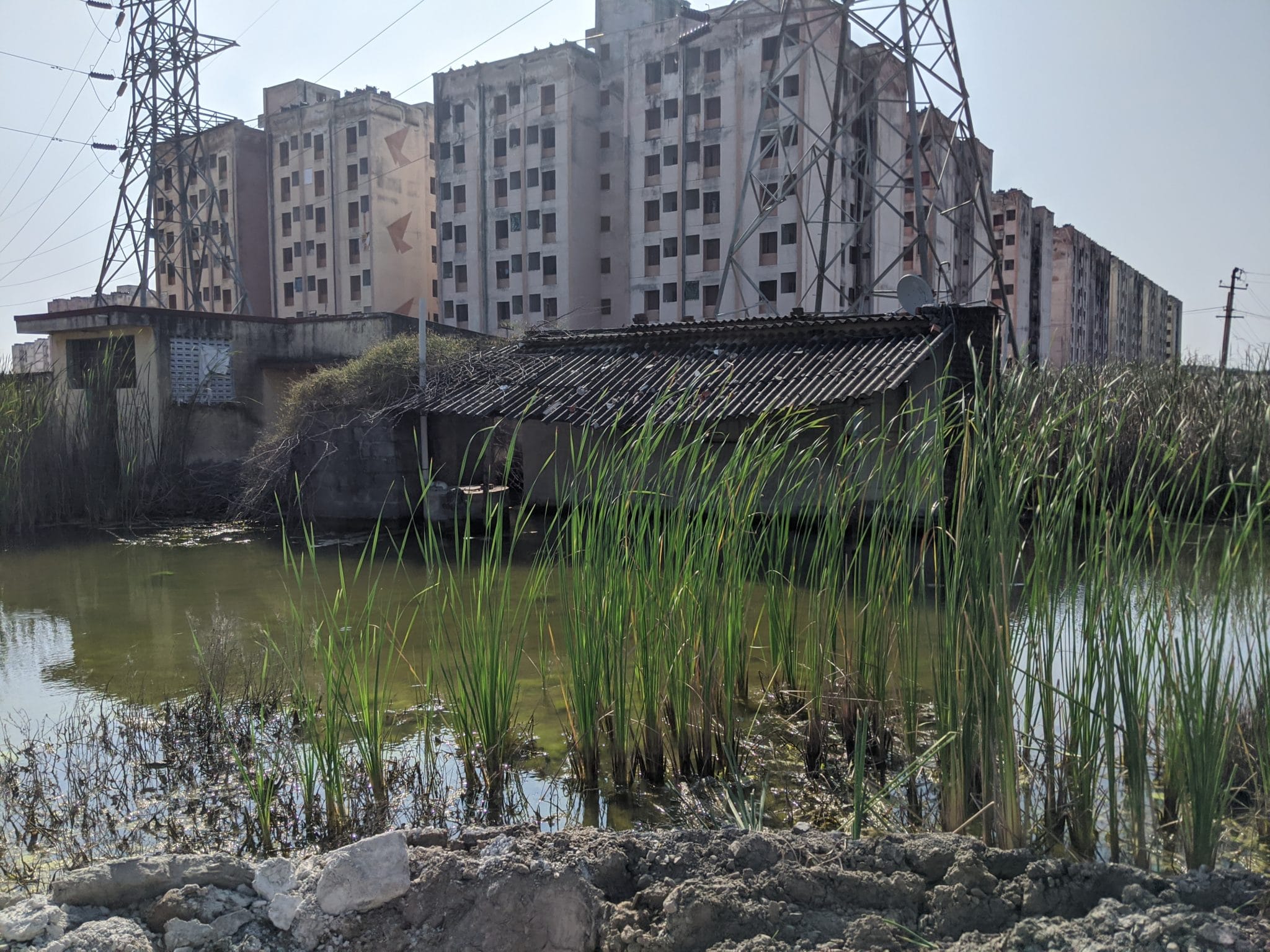
CRRT’s scope is limited, says S. Vishwanathan, an official with the trust. Their main focus is restoring the allotted project areas. The trust, officials added in an email message, has not prioritized aesthetics or “allowed any real estate agency to pave for individual interest.” For decades they feel they have been caught between environmentalists, who want to restore function to the city’s heavily damaged waterways, and social advocates, who criticize the resulting displacement as unnecessary, unjust, and anti-poor. “CRRT gets sandwiched between these two,” Vishwanathan said.
Officials say they must walk the fine line of addressing flooding hazard and restoration, while meeting the needs of affected families. They also argue that they are being more surgical in their removals than is typically portrayed by critics. “My focus is not to remove the entire slum,” said Vishwanathan. “We identified that part of the slum that lies within the river itself.”
The resulting impact on families is addressed in an official “Resettlement & Rehabilitation Scheme” for affected families — people like Vasanth and his family — who are deemed vulnerable to flooding. Officials point to social and community development programs, financial relief, and a provision of utilities and basic services. Acknowledging the difficulty of the distant displacement, Vishwanathan says the alternative is worse. “They lose everything every year” to flooding, he said, and they have no facilities. According to Vishwanathan, the resettlement colonies are a step up.
Yet years of documentation and research by advocates have shown that the evictions have negative impacts on the livelihood of residents. The issue, according to a World Bank report published in February, is that the Tamil Nadu Slum Clearance Board, which is ultimately in charge of the resettlement and rehabilitation of families, “does not have a standardized environmental or social framework” for projects. Instead, “it implements ad-hoc measures” to suit each intervention. The Covid-19 pandemic further exposed these deficiencies, as enforced lockdowns left residents struggling to survive in isolation.
“While TNSCB is experienced in managing physical construction and delivering housing units, they do not have all the necessary expertise or experience in addressing key issues,” World Bank representatives wrote to Undark in an email. Issues, they say, like ensuring residents have the means to secure an economic livelihood, and an environmentally sustainable, climate-resilient apartment building.
Despite evictee grievances, removing families may still be necessary, they say. While relocating families to nearby housing is always preferable, it is often not an option, and displacing families from the riverbank is necessary due to the high risk and inhabitability.
As of now, officials say, the TNSCB has indicated willingness to expand social and environmental reforms.
In late June, The Government of Tamil Nadu signed on to a $250 million dollar project with the World Bank to “strengthen the state’s housing sector policies, institutions, and regulations.” It is part of a two-pronged approach to shift the responsibility for the development of low-income housing away from the TNSCB and the public sector more broadly and encourage more private sector involvement. The program also indicates expanded environmental and social reforms to alleviate some of the current housing development concerns.
So far, advocates have criticized the Tamil Nadu government for lack of transparency, citing the lack of community participation of the most impacted communities, like Vasanth’s. The policy draft was unavailable for community input, and furthermore, there was no copy in Tamil, the local language.
In the neighborhoods being razed like Sathyavani Muthu Nagar, most residents were wage laborers, autorickshaw drivers, and domestic workers. Some families had ties to the area along the river going back three or four generations. Now in the new settlements, many families are saddled with arduous, expensive, and often impossible journeys to the city in order to maintain work.
At such distances, many displaced residents are effectively locked out of the predominantly working class, cash-based network that undergirds Chennai’s dense urban economy. Schools, public safety, and health care services are also scarce and inadequate in these colonies, according to a 2019 report by the Information and Resource Center for the Deprived Urban Communities. Other public services are cost-prohibitive for most settlement residents, according to research by the Housing and Land Rights Network, a New Delhi-based human rights organization. The concentration of poverty contributes to high crime rates, and despite government efforts, access to electricity, water, and affordable food is often unreliable.
In December, the evictions in Sathyavani Muthu Nagar were temporarily halted amidst widespread protest and civil disobedience. Two residents jumped into the putrid river to demand the government at least postpone the evictions until after their children completed exams. And even advocates for river restoration and better water resource management say that Chennai’s relentless displacement of poor and working families is unfair. The best-case scenario, they say, would be relocation to government lands located within the city center. “The worst-case scenario,” said Janakarajan, “is what we are seeing today.”
Having lived along the Cooum for years, Vasanth recalls the impact the 2015 floods had on his community. “People who live down by the river really struggled during the flooding,” he said. “Water entered all the houses.” Many families lost their dwellings completely. Vasanth’s home was located above the bank, however, and was spared any damage.
When the TNSCB came to evict the first batch of 500 families, Vasanth’s included, he couldn’t understand why. “They didn’t give any reason, like flooding, they just told us it was dangerous to live near the river,” he recalled. Dangerous for some, he argued, but his family had been spared over years of cyclones and floods.
For Vasanth, Sathyavani Muthu Nagar was more livable than Perumbakkam, the resettlement colony where he was delivered early this year. Before the eviction, everything was nearby: food, work, his community. Perumbakkam, he says, is too far removed, and most of his money would have to go to paying for bus tickets to travel back into the heart of Chennai for work. “I miss everything,” Vasanth said. “Everything was near to us.”
A 2017 report from the IRCDUC found that resettlement job programs were lacking, with little follow-through. Faced with overcrowded, mismanaged schools, students dropped out at high rates after displacement across the resettlement sites; if they decided to keep their existing schools, the average daily commute would be between three and five hours. Parents were also hesitant to send students to school citing poor educational quality and safety concerns, especially for girls.
The tenements themselves are also barely livable at times. Residents reported having to sleep outside the buildings until their apartment is finished being built, and when it is, some had to still wait for electricity. If elevators do not work, some residents must carry heavy water jugs up as much as eight stories, a near impossible task for older or disabled residents.
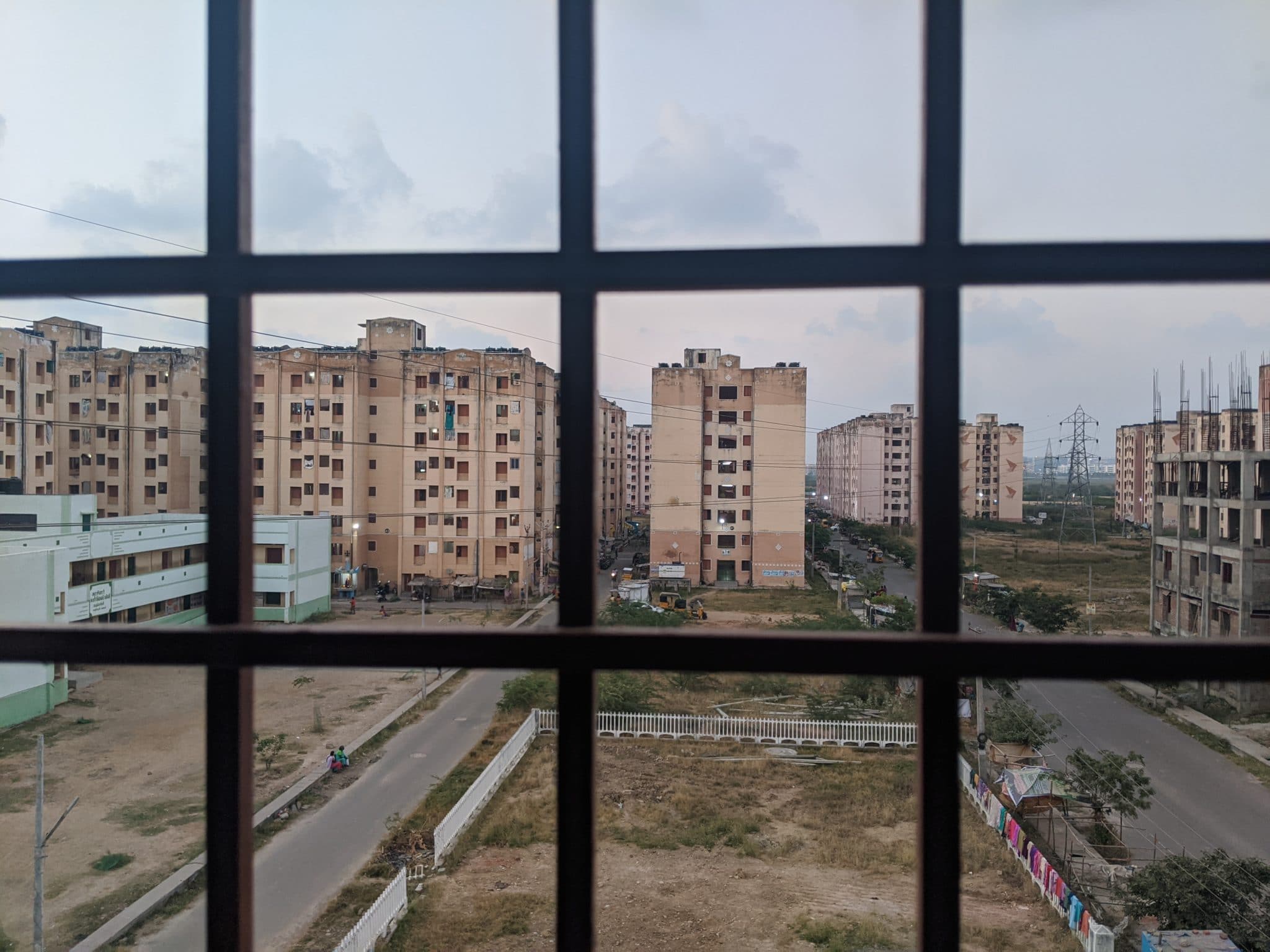
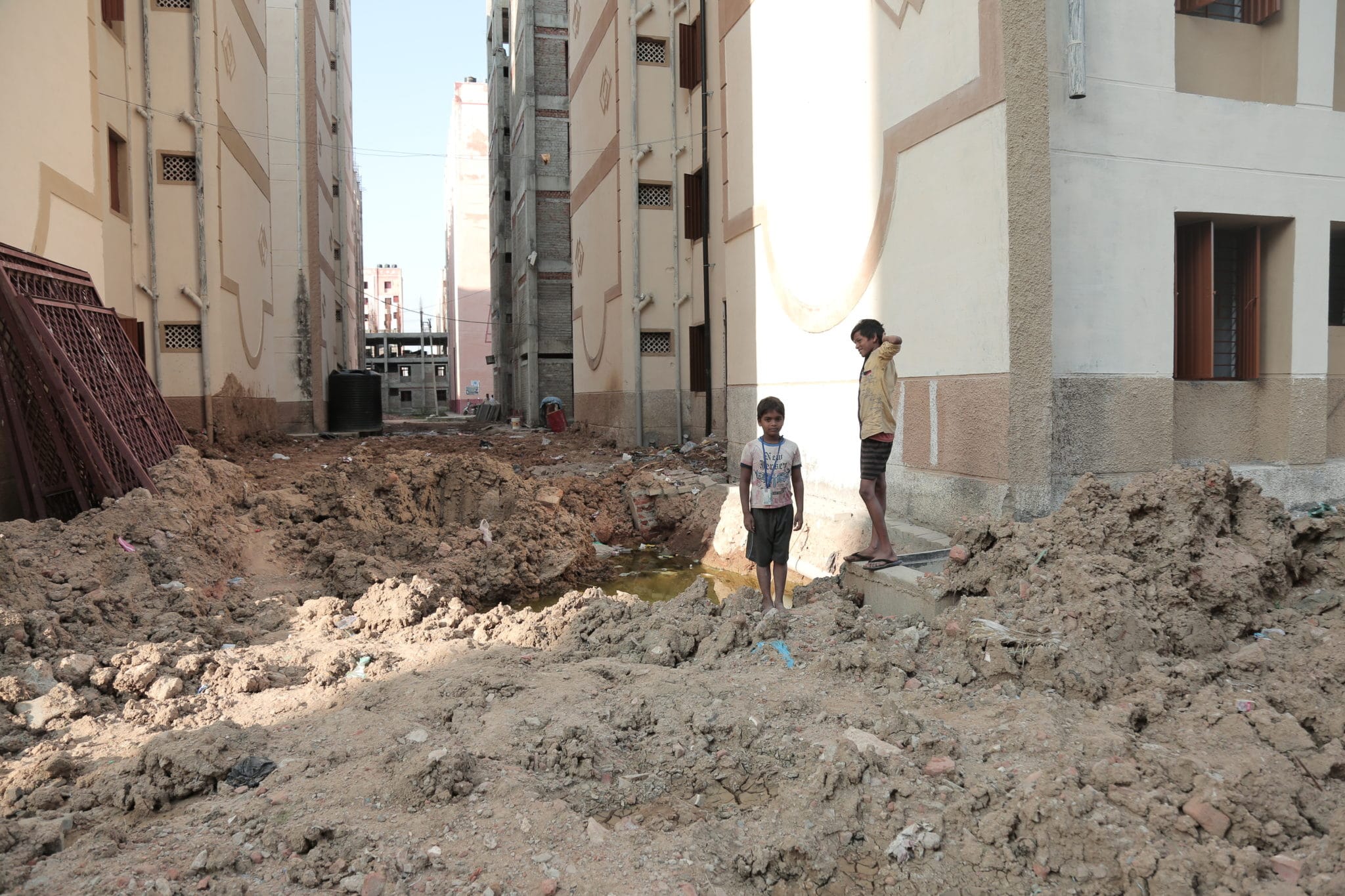
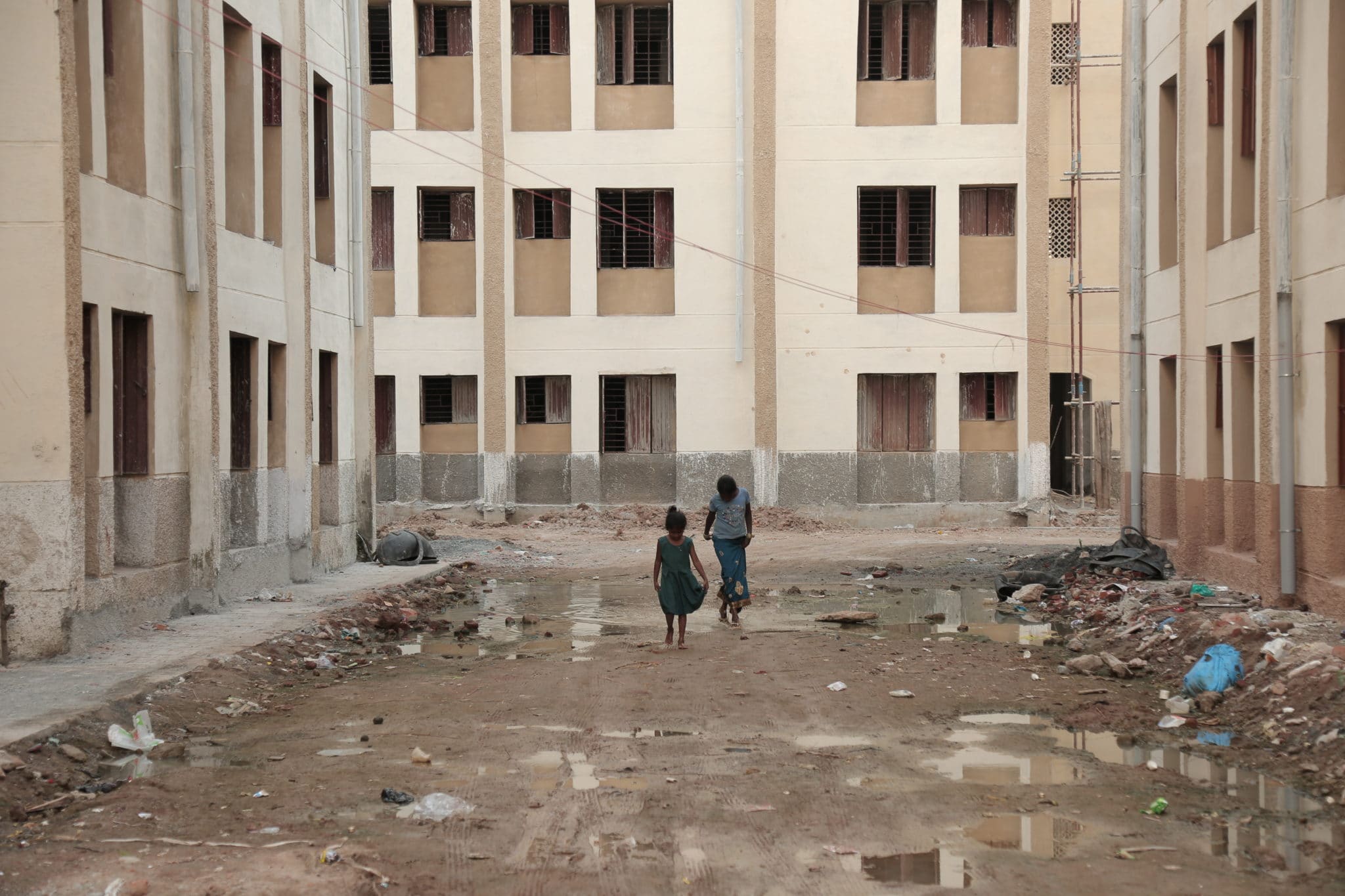
When they arrived, Vasanth’s family was originally assigned a seventh story apartment. However, the elevator did not work, and his pregnant sister in law was unable to make it up the stairs. The only other available apartment was without water or electricity. The community comes together to share resources, but, still, Vasanth says, it is unbearable. “Right now, the situation is the same. It is very difficult. Five months they have not done anything. There are so many people struggling hard in our apartment.”
He wished they could have stayed in their home along the Cooum. “If they cleaned the river and gave a house in the same place, I would have been happy,” he says. “What is the point of them evicting us here? There is no electricity, there is no water.”
According to data collected by the Tamil Nadu Slum Clearance Board, more than 16,000 families have been relocated as a direct consequence of river restoration along the Cooum and Adyar Rivers. Some 42,000 more are slated to follow from around Chennai. For now, however, evictions have halted as Covid-19 spreads throughout the city.
Peter and Coelho have both worked to research these resettlements, which they see as a discriminatory intervention. In India, a caste system is implicit in social decisions. The dominant numbers of informal settlement residents are of lower caste backgrounds, said Peter. Coelho says that the World Bank has at least shifted support towards a more equitable relocation strategy by including project safeguards. But both researchers remain concerned that people sent to these settlements face unacceptable living conditions.
Meanwhile, river restoration has become an initiative prioritized at the highest levels in India. Restoration activities are seen as a pathway to a modern, cleaned up, 21st-century nation, and ecological interventions will almost certainly be necessary to adapt to a rapidly changing climate, with stronger floods, droughts, and heat waves.
But Coelho suggested that so far these efforts have ignored, or given short shrift to, the most important questions.
“The first order of business when we are talking about ecology,” she said, “should be ‘what are we going to do about 50 to 60 thousand people?’”
Theo Whitcomb (@theo_whitcomb) is a Fulbright Scholar and writer based in Tamil Nadu.










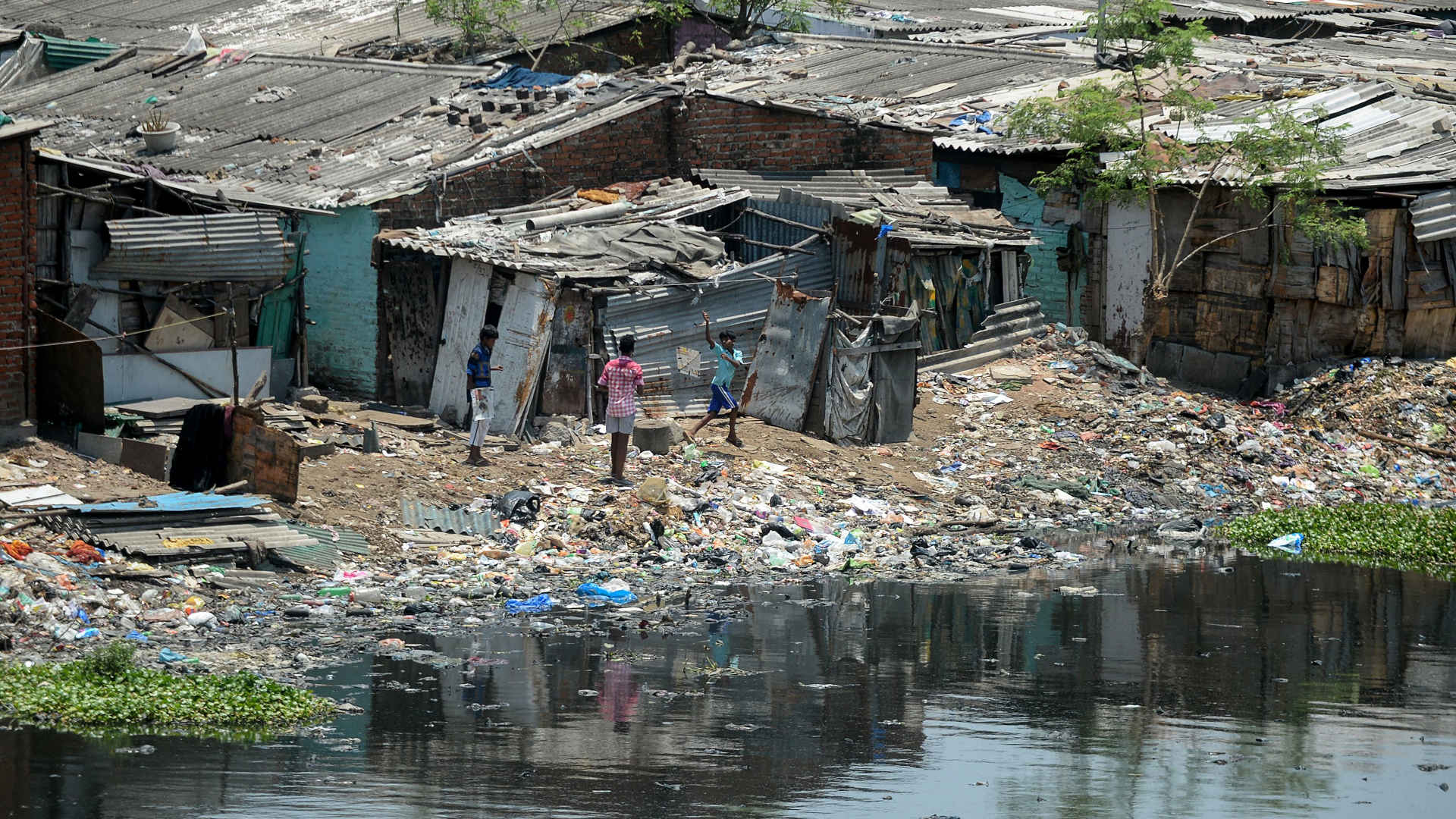
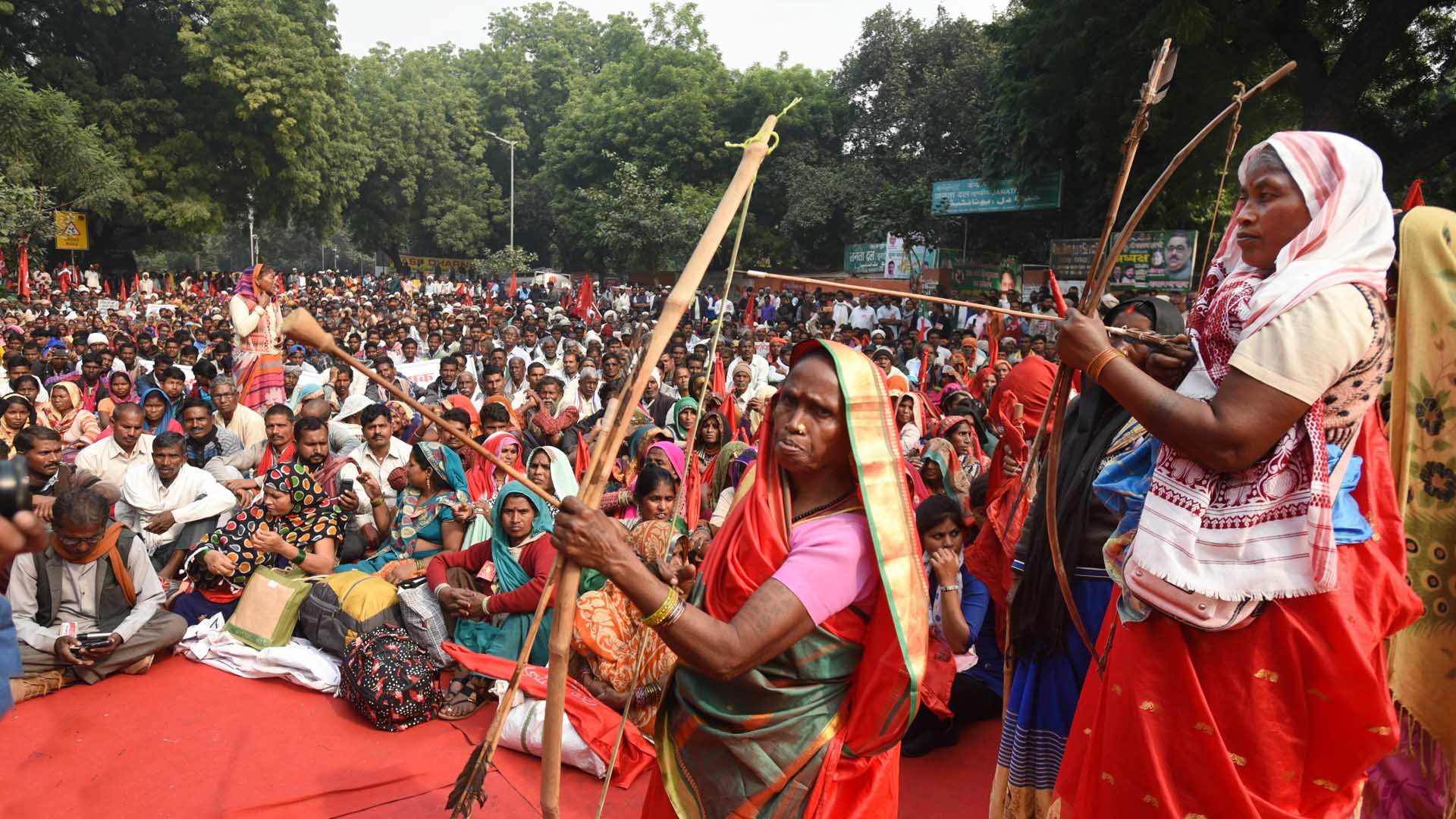
Comments are automatically closed one year after article publication. Archived comments are below.
Irresponsible journalism. They’re all illegal occupants. Because they occupy the riverside and riverways Chennai gets flooded during good and heavy rains.
This issue along the Bay of Bengal appears to mirror similar problems challenging the Indus, Brahmaputra, and Ganga watersheds. India needs reinvention of the philosophy of design applied in their approaches to addressing flooding and drought at the national level. Rather than large scale engineering projects however, they need to pursue a systems engineering approach which treats water management as an ensemble, rather than discrete technical individuals.
Super bro and thank you bro
Excellent journalism, Mr. Whitcomb. I was not aware of this heart-breaking situation until reading your article…